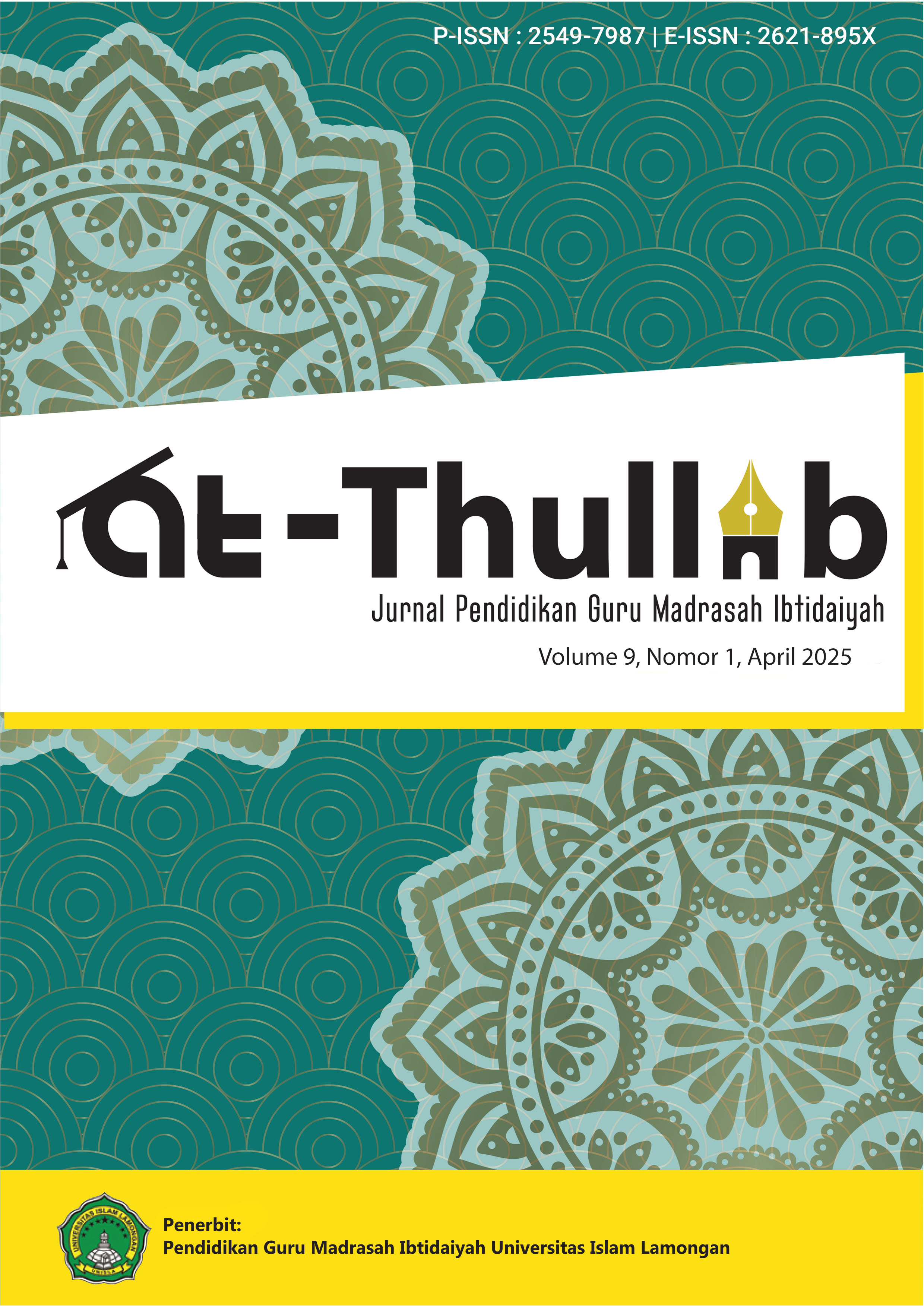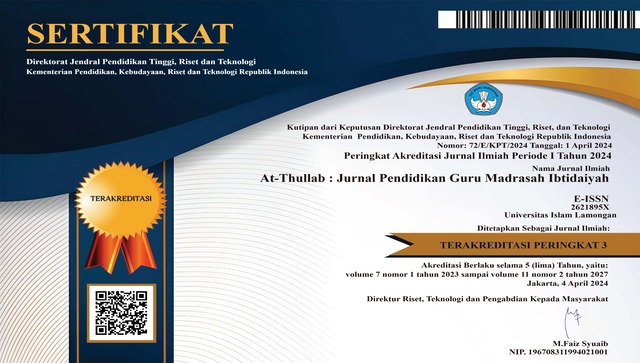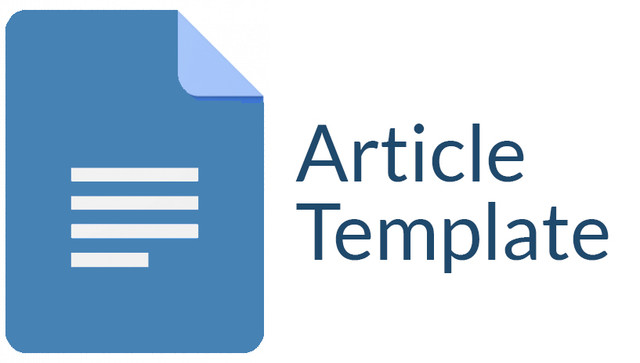Pencak Silat As a Character Building Strategy for Madrasah Ibtidaiyah Negeri 2 Serang Students; Thomas Lickona's Perspective
DOI:
https://doi.org/10.30736/atl.v9i1.2375Keywords:
Strategy , Character, Pencak Silat, StudentAbstract
Juvenile delinquency is currently rampant in society. There are many cases such as brawls, acts of violence, and truancy at school; for this reason, character formation in children is very important to be implemented from an early age. The study aims to analyze the strategy of instilling character values through extracurricular pencak silat at MIN 2 Serang, an Islamic elementary school in Serang, Banten. MIN 2 Serang was chosen as the location of the study because it has shown a positive impact on the formation of student character through pencak silat activities, which are part of the local culture of Banten. This study uses a qualitative approach with a descriptive case study method, and this study found that instilling character values is carried out through three stages: moral knowing, feeling, and doing. The results of the study indicate that the Character Value Instillation Strategy instilled by the trainer, namely using the Moral Knowing Strategy, fosters discipline, Moral Feeling instills empathy, and Moral Doing instills the value of responsibility, but from this instillation, there are supporting factors, including adequate facilities. At the same time, challenges such as the distance of students' homes become obstacles to character formation. This study contributes to developing a character education model rooted in local culture.
Downloads
References
Ahmad Rizki Muhibi & Chindi Widya Arifin. (2023). Creating Character Schools to Improve the Quality of Education in Indonesia. Khatulistiwa: Journal of Education and Social Humanities, 3(2), 70–78. https://doi.org/10.55606/khatulistiwa.v3i2.1436
Albany, D. A. (2021). The Realization of Character Education in the Contemporary Era Based on the Perspective of Ki Hajar Dewantara. Jurnal Humanitas: Catalyst of Change and Innovator of Education 7(2), 93–107. https://doi.org/10.29408/jhm.v7i2.3393
Bastomi, H. (2018). Character Education in the Formation of Pre-School Children's Akhlak. Elementary: Islamic Teacher Journal, 5(1), 84. https://doi.org/10.21043/elementary.v5i1.2982
Belladonna, A. P., & Adha Septiana, R. (2022). The Pencak Silat College in Developing National Character: Paguron Pencak Silat in Developing National Character Journal of Physical and Outdoor Education, 4(2), 183–194. https://doi.org/10.37742/jpoe.v4i2.179
Deri, R. A. (2024). The role of pencak silat in Indonesia-America soft diplomacy. Journal of Mandalika Literature, 5(3), 627–634. https://doi.org/10.36312/jml.v5i4.3796
Farhurohman, O., Citra, R. A., & Afinatussakinah, S. (2024). ntegration of character values through Pancasila education learning in the era of society 5. O in elementary schools. Ibriez Journal: Journal of Islamic Elementary Education Based on Science, 9(2), 233–244. https://doi.org/10.21154/ibriez.v9i2.620
Fitriyadi, M. Y., Rahman, M. R., Asshidiqi, M. R. A., Ilham, M. A., Aibina, O. I., Hesda, N., & Al Fayyedh, F. (2023). The influence of the IT world on the behavior of generation z teenagers. Religion: Journal of Religion, Social, and Culture, 2(2), 21–37. https://doi.org/10.55606/agama.v1i2.61
Ibda, F. (2023). Moral Development in Lawrence Kohlberg's View. Intelektualita, 12(1). https://doi.org/10.22373/ji.v12i1.19256
Ketaren, E. (2017). Cybercrime, Cyberspace, dan Cyber Law. Journal Times, 5(2), 35–42. https://doi.org/10.51351/jtm.5.2.2016556
Kholis, M. N. (2016). Application of the noble values of pencak silat as a means of forming national morality. Journal Sportif, 2(2). https://doi.org/10.29407/js_unpgri.v2i2.508
Kurniawan, A. N., Nola, R., & Fibia, C. C. N. (2024). Formation of Tolerance Character through PAI: Analysis of Social Learning Theory in Malang. Civilization Journal of Interdisciplinary Educational Research, 2(2), 27–41. https://doi.org/10.59001/pjier.v2i2.64
Lalo, K. (2018). Creating a Millennial Generation with Character with Character Education to Welcome the Era of Globalization. Journal of Police Science, 12(2), 8. https://doi.org/10.35879/jik.v12i2.23
Latief, S. (2020). Early Childhood Education (Paud) As A Foundation for Character Formation In The Era Of Revolution 4.0 And Society 5.0: Techniques And Continuity Of Character Education. Journal Literasiologi, 3(2). https://doi.org/10.47783/literasiologi.v3i2.92
Lickona, T. (2022). Educating to shape character. Bumi Aksara.
Mainuddin, M., Tobroni, T., & Nurhakim, Moh. (2023). Al-Ghazali's Character Education Thoughts, Lawrence Kolberg and Thomas Lickona. Attadrib: Journal of Elementary Madrasah Teacher Education, 6(2), 283–290. https://doi.org/10.54069/attadrib.v6i2.563
Mardotillah, M., & Zein, D. M. (2017). Silat: Cultural identity, education, martial arts, health maintenance. Journal of Anthropology: Socio-Cultural Issues 18(2), 121–133. https://doi.org/10.25077/jantro.v18.n2.p121-133.2016
Mufarriq, M. U. (2021). Forming Youth Character Through Pencak Silat. Khazanah Pendidikan Islam, 3(1), 41–53. https://doi.org/10.15575/kp.v3i1.10193
Murni, D. E. S., & Feriyal, F. (2024). The relationship between authoritarian parenting patterns and juvenile delinquency in class XI at SMK Telematika Sindangkerta, Indramayu Regency. Nautical: Indonesian Multidisciplinary Scientific Journal 2(12). https://doi.org/10.55904/nautical.v2i12.661
Novita, N. N. I. (2023). Strengthening Digital Ethics Through the Material "Ethics in Using Social Media" in Islamic Religious Education Subjects in Forming Student Character Facing the Society 5.0 Era. Journal of Education and Learning Sciences, 3(1), 73–93. https://doi.org/10.56404/jels.v3i1.45
Nugraha, Y., & Rahmatiani, L. (2019). Supporting and Inhibiting Factors in the Implementation of Extracurricular Activities in Building Student Discipline Character. Journal of Community Morals 3(2), 64–70. https://doi.org/10.21067/jmk.v3i2.2900
Nurhisam, L. (2018). Implementing Character Education As Solution Of Children Moral Decadence. Elementary: Islamic Teacher Journal, 5(1), 110. https://doi.org/10.21043/elementary.v5i1.2983
Nurhovivah, D. A. (2024). Contribution of Islamic Religious Education Teachers in Forming the Religious Tolerance Character of Students at Dharma Karya Elementary School UT Pondok Cabe Tangerang Selatan
Pradana, Y. (2016). Student Character Development Through School Culture Untirta Civic Education Journal, 1(1). https://doi.org/10.30870/ucej.v1i1.1883
Pridayani, M., & Rivauzi, A. (2022). Supporting and Inhibiting Factors in the Implementation of the Religious Character Education Strengthening Program for Students. An-Nuha, 2(2), 329–341. https://doi.org/10.24036/annuha.v2i2.188
Rachmawati, S. N. I. (2016). Efforts to build student character through extracurricular activities of pencak silat at MI Sultan Agung Babadan Baru Sleman. Sunan Kalijaga State Islamic University of Yogyakarta.
Risnaedi, A. S. (2021). Concept of Handling Deviant Student Behavior. Adab Publisher.
Rusli, T. S., Kemala, R., & Nazmi, R. (2024). Gen-Z Character Education: Tips and Tricks for Educating Gen-Z Character for Educators. PT. Sonpedia Publishing Indonesia.
Santika, D. A., Irhamudin, I., & Arifin, M. Z. (2024). The Role of Pencak Silat Pagar Nusa in Cultivating the Character of the Young Generation. Scientific Periodical of Education, 4(1), 143–152. https://doi.org/10.51214/bip.v4i1.891
Saputra, D. N., Djuwita, P., & Juarsa, O. (2019). nstilling Character Values in Local Culture-Based School Culture at SDN Mardiharjo, Musi Rawas Regency. Journal of Elementary Education Learning and Teaching, 2(1), 98–106. https://doi.org/10.33369/dikdas.v2i1.8690
Downloads
Published
How to Cite
Issue
Section
License
Copyright (c) 2025 Ririn Anggita Citra, Khaeroni Khaeroni, Oman Farhurohman

This work is licensed under a Creative Commons Attribution-ShareAlike 4.0 International License.
Authors who publish with this journal agree to the following terms:
The journal allow the authors to hold the copyright without restrictions and allow the authors to retain publishing rights without restrictions. Authors retain copyright and grant the journal right of first publication with the work simultaneously licensed under a Creative Commons Attribution-ShareAlike 4.0 International License. that allows others to share the work with an acknowledgement of the work's authorship and initial publication in this journal.
Authors are able to enter into separate, additional contractual arrangements for the non-exclusive distribution of the journal's published version of the work (e.g., post it to an institutional repository or publish it in a book), with an acknowledgement of its initial publication in this journal.
Authors are permitted and encouraged to post their work online (e.g., in institutional repositories or on their website) prior to and during the submission process, as it can lead to productive exchanges, as well as earlier and greater citation of published work (See The Effect of Open Access).
The journal allows third parties (readers, researchers, and others) to share and adapt the material in line with the license. In addition, the material must be given appropriate credit, provided with a link to the license, and indicate if changes were made. If authors remix, transform, or build upon the material, they must distribute their contributions under the same license as the original.













